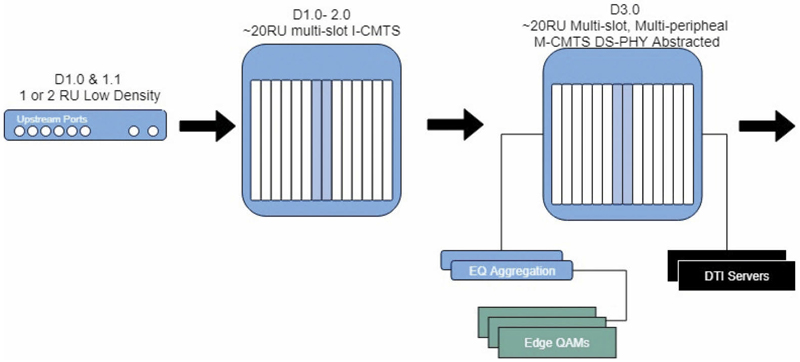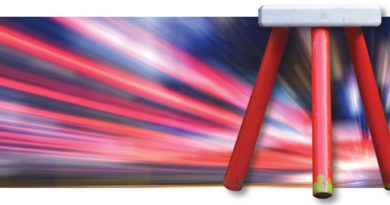It’s Virtually the Same Thing, Right?…
By Kraig Neese –
The delivery of the Internet over a piece of coax has taken quite the journey in the last couple of decades. Things have been mostly consistent from the pre-DOCSIS days of proprietary suppliers to the varied makers of DOCSIS-based CMTS platforms—big iron boxes with cables hanging out the back of them. For those of us who started in this world around the turn of the century, we have seen quite a few changes. Building, operating, and maintaining these unique boxes, marrying RF to IP, became a lifestyle for many of us. From the humble beginnings of quaint-sized DOCSIS 1.0 platforms with fast-Ethernet uplinks, we took part in the extraordinary journey of replacing, renewing, reinventing, and continuously reinvigorating our narrow slice of technology—a technology that has fed and continues to feed the insatiable appetite of our customers for more and more bytes. It was almost an art form of operational ballet to enhance the existing network with new bolt-on parts to dropping new platforms in place. We started with small integrated platforms that rapidly grew into 20 RU-plus behemoths, with density growing by the year. From I-CMTS with all the giblets in one piece to M-CMTS. We made facility managers cringe with all the new fancy edge-QAM modulators and DTI servers we had to install to separate the downstream PHY. When CCAP came along, we all breathed a short sigh of relief because we got back to a less sophisticated physical install with all the giblets being put back in the same box. I remember how the physical installation was so much easier than M-CMTS. Then, the fancy top hat-wearing uncle of M-CMTS came along in the form of DAA and remote PHY, and we once again spread all our toys for CCAP cores, auxiliary cores, aggregation, and optical multiplexing around the facilities. The entire PHY left the building as we cast off that function to RPD-equipped nodes in the field. The physical journey of our beloved platform has ebbed and flowed in size and complexity over the years. The configurations of devices have continued to become larger and more complex. Despite the complexity, the tooling used to manage these devices has remained mostly the same. SSH-based tools scraping or changing configs, syslog receivers, SNMP pollers, are just a few things that have been a constant constellation guiding us.

When DAA and R-PHY arrived on the scene, operational boundaries blurred, and many design and operations teams found themselves sharing a small studio apartment while delivering their products from the now-converged infrastructure. Non-DOCSIS RF-based services were serving from the same device and pumped over an IP stream to the new digitally linked R-PHY nodes in the field. However, even with the DAA and R-PHY era being as transformative to our operating environment as it was, we still lived comfortably in our big iron box back at the headend. We survived the greatest effort so far in our DOCSIS journey. The expansion of the I-CMTS to M-CMTS, the contraction back to I-CCAP, the expansion to DAA/R-PHY. The journey to using CCAP as intended was finally here and DAA/R-PHY is where many of us are and are still growing strong.

It has been a hectic two decades of evolving the DOCSIS world to this state, to say the least. If breathing room were the hope after all that, it would be best to take deep breaths and prepare for the greatest and possibly last evolution we DOCSIS engineers may see. The days of our big iron friends and our heavy boxes of comfort will be gone as we welcome our new, much skinnier, and scalable friends. The age of virtualized CMTS is upon us, and racks of computing power will be our new weapon in the fight for more service groups and bandwidth. The virtualized CMTS, vCMTS, is not new and has been hanging out for a few years. Like most things in technology, adoption takes time for plans to come out of the ether and gel into something tangible. Unlike our past big iron buddies, which were typically managed by traditional tools, the vCMTS ushers in the world of new data gathering, management, and physical installation. Streaming telemetry, fully embracing capabilities like NETCONF for config management and provisioning instead of SSH. Containerized upgrades to update a single function and the threat of the traditional CLI going away bring a whole new operational environment to the table. On the physical side, we need to connect stacks of servers and aggregation routers in the same cabinet to AC or DC power and to the network. Servers that need multi-hundred gig uplinks and diverse power. Data centers worldwide have thankfully paved the way in this arena for us to follow. However, latency performance will drive the need to place these compute racks inside the same headends alongside their big iron cousins. That much density in one place can make things interesting in aging sites where heat exchange and power might be stressed already. Servers produce a lot of heat in a small area, so site engineers will have to consider whether spreading out those BTUs across multiple cabinets or possibly diverse areas is needed. The cable industry has dealt with this continued increase in density, which will not be a foreign concept. Nonetheless, it is a significant departure from our past installs of one big box with fewer densely packed uplinks and heat generation in one place.

Physical installation aside, the blurred lines of operations continue into yet another fuzzy pattern of new teams, tools, and techniques for pushing and pulling data from the CMTS. IP networking teams will see some of the aggregation formerly done in a CMTS chassis moved to their devices. Software teams not traditionally involved in the maintenance of the CMTS will enter the scene a bit more. Those software teams building automation will be able to shine at their brightest. They can finally use non-CLI methods for configuration management, provisioning, upgrade operations, and monitoring. Big data teams will feel the flow of more information coming at them and soon figure out how to use such info to drive network maintenance behavior and increase performance. It will be hard for us old CLI dogs to let go, but we must. At least for front-end provisioning and configuration, someone still must get in there when things go sideways and untangle a mess.
R-PHY was the mid-level class for blending operational boundaries. vCMTS will take us to the advanced classes of blended operations as automation overtakes CLI. Tools must mature and fit the operational environment so that DOCSIS operators can effectively support this new virtual world. The CMTS world we know is about to change for likely the last time and in a significant way. Seeing the CMTS broken into little virtual containers is exciting and terrifying. Relearning the job has been a staple of a DOCSIS engineer, and this is no different. The new learning on this revamp will make us server administrators whether we like it or not. Understanding the functions of Docker, Kubernetes, NETCONF, and generally how containerization works in a clustered environment are going to be a few new mandatory skill sets required to maintain a mastery of design and operations of the vCMTS world. So, raise a toast to our faithful big iron companion who has and will continue to, for a short time more, serve us well. We welcome our new virtual friends to take us all the way to the final days of DOCSIS.

Kraig Neese
Cable Access Engineer,
Cox Communications, Inc.
Kraig Neese is a Cable Access Engineer at Cox Communications. He has spent the last 24 years in the cable industry with Cox Communications. He spent his first 17.5 years in the Phoenix market, where he was involved in the various evolutions of DOCSIS platforms from DOCSIS 1.0 to the first launches of 3.0 and 3.1. He joined the Atlanta Access Engineering Team in 2018 and has been focused on supporting remote PHY on an operations and design level.
Images provided by author
Shutterstock




